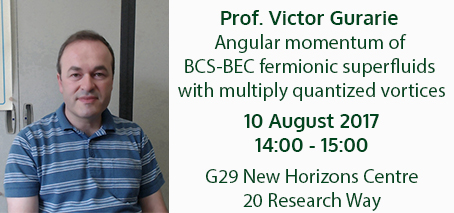-
FLEET Research Seminar: Victor Gurarie
10 Aug 2017
2:00 pm - 3:00 pm
Angular momentum of BCS-BEC fermionic superfluids with multiply quantized vortices
Please click here for Seminar flyer. All welcome.
Hear Bose-Einstein condensate research from University of Boulder Colorado regarding quantised vortices and superfluidity — key to dissipationless particle flow studied at FLEET to address the growing issue of global computing energy use.
Superfluidity (the dissipationless flow of particles) requires particles to be bosons, which can be in the same quantum state. Paired, opposite-spin fermions behaving as a single boson are described by BCS (Bardeen-Cooper-Schrieffer) theory and result in superfluidity of the paired particles. The BCS-BEC framework describes how superfluidity manifests as the strength of fermion interactions varies from weak to strong.
Prof Gurarie’s research has unearthed a surprising relationship between the number of quantised vortices and whether the superfluid is in the BCS or BEC regime.
Abstract: Angular momentum of a Bose-Einstein condensate in the presence of a quantized vortex is known to be ℏ times the number of particles in the condensate. In the presence of a vortex of vorticity larger than 1, the angular momentum is then ℏ times the vorticity times the number of particles. This obviously also works in the far BEC regime of the BCS-BEC fermionic superfluid with a vortex, where the angular momentum is ℏ times the vorticity times the number of bosonic molecules. I will discuss how this breaks down in the BCS regime of a fermionic superfluid with vortices of vorticity larger than 1, where the angular momentum turns out to be significantly lower than in the BEC regime.
About the speaker: Prof Gurarie is Director of the Center for Theory of Quantum Matter at the University of Colorado Boulder, researching macroscopic quantum matter, unifying condensed matter, atomic, molecular and optical physics, nuclear physics and quantum information science.
Within FLEET, Prof Gurarie is working with Chris Vale (Swinburne University of Technology) to experimentally realise a quenched p-wave topological superfluid that generates self-sustained Floquet topological superfluidity with no external driving, and with Kris Helmerson (Monash University) on the quantum kicked-rotor setup to measure critical exponents in the quantum Hall effect.
Gurarie, Vale and Helmerson collaborate within FLEET’s light-transformed materials research theme, in which materials are temporarily forced into a topological or superfluid state. Systems driven far from thermal equilibrium exhibit qualitatively different physics, with new capabilities for controlling their behaviour.
This ‘perfect testbed’ research allows fine control of phase transitions to bring new theoretical understanding of ultra-low dissipation in materials, which will inform the design of permanent topological and superfluid materials.
Ultra-low dissipation topological and superfluid systems will form the basis of new electronics developed at FLEET to address the growing issue of energy use in computing, which makes up 5% of global electricity use, and is doubling every decade.
Visitors & parking at Monash Clayton Visitors are very welcome to attend seminars. A map of the Clayton campus can be found online. There are designated visitors car parks in the “N1” building (marked in blue, towards top left of the map) just west of the New Horizons Building. Visitor spaces are available on the ground floor (limited spaces, enter off Research Way gate 10) and top floor (level six, lots of spaces, enter via gate 2 off Innovation Walk). Tickets are $10/day or $2/hour, available from machines. More information.
Venue: G29 New Horizons Centre, Monash University
Venue Website: https://www.monash.edu/engineering/our-research/facilities/new-horizons
Address:
